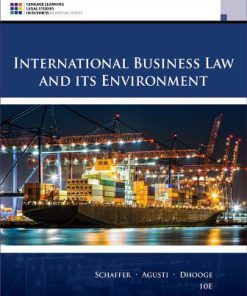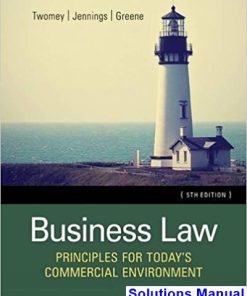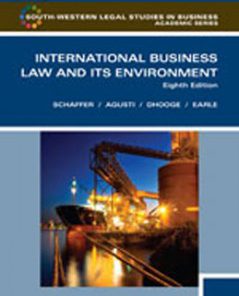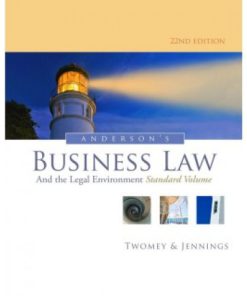Business Law Principles for Todays Commercial Environment 5th Edition Twomey Test Bank
$55.00 Original price was: $55.00.$29.99Current price is: $29.99.
Business Law Principles for Todays Commercial Environment 5th Edition Twomey Test Bank
Business Law Principles for Todays Commercial Environment 5th Edition Twomey Test Bank
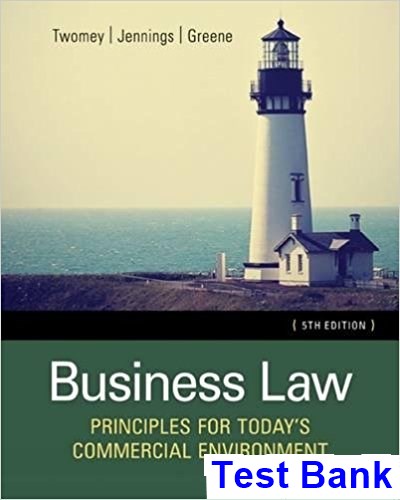
Product details:
- ISBN-10 : 1305870336
- ISBN-13 : 978-1305870338
- Author: Professor David Twomey
You can trust BUSINESS LAW: PRINCIPLES FOR TODAY’S COMMERCIAL ENVIRONMENT, 5E to help you build the skills you need to ace your business law course. This new edition also provides key information and resources to assist you in studying and succeeding on the CPA exam. This book’s clear presentation helps you grasp key legal concepts and principles and reinforce your understanding through applications and examples of real-world dilemmas, issues, and problems. Current, comprehensive, easy-to-understand and fascinating to read, BUSINESS LAW: PRINCIPLES FOR TODAY’S COMMERCIAL ENVIRONMENT helps you prepare for class with all the resources you need to succeed in your business law course. In addition, new MindTap, a fully online, highly personalized learning experience, is available to help maximize your course success.
Table contents:
- Part 1: The Legal and Social Environment of Business
- Chapter 1: The Nature and Sources of Law
- 1-1 Nature of Law and Legal Rights
- 1-1a Legal Rights
- 1-1b Individual Rights
- 1-1c The Right of Privacy
- 1-1d Privacy and Technology
- 1-2 Sources of Law
- 1-2a Constitutional Law
- 1-2b Statutory Law
- 1-2c Administrative Law
- 1-2d Private Law
- 1-2e Case Law, Statutory Interpretation, and Precedent
- 1-2f Other Forms of Law: Treaties and Executive Orders
- 1-2g Uniform State Laws
- 1-3 Classifications of Law
- 1-3a Substantive Law vs. Procedural Law
- 1-3b Criminal Law vs. Civil Law
- 1-3c Law vs. Equity
- Chapter 2: The Court System and Dispute Resolution
- 2-1 The Court System
- 2-1a The Types of Courts
- 2-1b The Federal Court System
- 2-1c State Court Systems
- 2-2 Court Procedure
- 2-2a Participants in the Court
- 2-2b Which Law Applies—Conflicts of Law
- 2-2c Initial Steps in a Lawsuit
- 2-2d The Trial
- 2-2e Post-trial Procedures
- 2-3 Alternative Dispute Resolution (ADR)
- 2-3a Arbitration
- 2-3b Mediation
- 2-3c MedArb
- 2-3d Expert Panel
- 2-3e Reference to a Third Person
- 2-3f Association Tribunals
- 2-3g Summary Jury Trial
- 2-3h Rent-A-Judge
- 2-3i Minitrial
- 2-3j Contract Provisions
- Chapter 3: Business Ethics, Social Forces, and the Law
- 3-1 What Is Business Ethics?
- 3-1a The Law as the Standard for Business Ethics
- 3-1b The Notion of Universal Standards for Business Ethics
- 3-1c Ethical Theories and Standards
- 3-1d The Business Stakeholder Standard of Behavior
- 3-2 Why Is Business Ethics
- 3-2a The Importance of Trust
- 3-2b Business Ethics and Financial Perfromance
- 3-2c The Importance of a Good Reputation
- 3-2d Business Ethics and Business Regulation: Public Policy, Law, and Ethics
- 3-3 How to Recognize and Resolve Ethical Dilemmas
- 3-3a Categories of Ethical Behavior
- 3-3b Resolving Ethical Dilemmas
- Chapter 4: The Constitution as the Foundation of the Legal Environment
- 4-1 The U.S. Constitution and the Federal System
- 4-1a What a Constitution Is
- 4-1b The Branches of Government
- 4-2 The U.S. Constitution and the States
- 4-2a Delegated and Shared Powers
- 4-2b Other Powers
- 4-2c Federal Supremacy
- 4-3 Interpreting and Amending the Constitution
- 4-3a Conflicting Theories
- 4-3b Amending the Constitution
- 4-3c The Living Constitution
- 4-4 Federal Powers
- 4-4a The Power to Regulate Commerce
- 4-4b The Financial Powers
- 4-5 Constitutional Limitations on Government
- 4-5a Due Process
- 4-5b Equal Protection of the Law
- 4-5c Privileges and Immunities
- 4-5d Protection of the Person
- 4-5e The Bill of Rights and Businesses as Persons
- Chapter 5: Government Regulation of Competition and Prices
- 5-1 Power to Regulate Business
- 5-1a Regulation, Free Enterprise, and Deregulation
- 5-1b Regulation of Unfair Competition
- 5-2 Regulation of Horizontal Markets and Competitors
- 5-2a Regulation of Prices
- 5-2b Monopolization
- 5-2c Boycotts and Refusals to Deal
- 5-2d Mergers among Competitors
- 5-3 Regulation of the Supply Chain and Vertical Trade Restraints
- 5-3a Price Discrimination
- 5-3b Exclusive Dealings and Territories
- 5-3c Resale Price Maintenance
- 5-3d Tying
- 5-3e Mergers along the Supply Chain
- 5-4 Remedies for Anticompetitive Behavior
- 5-4a Criminal Penalties
- 5-4b Civil Remedies
- Chapter 6: Administrative Agencies
- 6-1 Nature of the Administrative Agency
- 6-1a Purpose of Administrative Agencies
- 6-1b Uniqueness of Administrative Agencies
- 6-1c Open Operation of Administrative Agencies
- 6-2 Legislative Power of the Agency
- 6-2a Agency’s Regulations as Law
- 6-2b Agency Adoption of Regulations
- 6-3 Executive Power of the Agency
- 6-3a Enforcement or Execution of the Law
- 6-3b Constitutional Limitations on Administration Investigation
- 6-4 Judicial Power of the Agency
- 6-4a The Agency as a Specialized Court
- 6-4b Punishment and Enforcement Powers of Agencies
- 6-4c Exhaustion of Administrative Remedies
- 6-4d Appeal from an Administrative Agency Action
- Chapter 7: Crimes
- 7-1 General Principles
- 7-1a Nature and Classification of Crimes
- 7-1b Basis of Criminal Liability
- 7-1c Responsibility for Criminal Acts
- 7-1d Indemnification of Crime Victims
- 7-2 White-Collar Crimes
- 7-2a Conspiracies
- 7-2b Money Laundering
- 7-2c Racketeering
- 7-2d Bribery
- 7-2e Commercial Bribery
- 7-2f Extortion and Blackmail
- 7-2g Corrupt Influence
- 7-2h Counterfeiting
- 7-2i Forgery
- 7-2j Perjury
- 7-2k False Claims and Pretenses
- 7-2l Bad Checks
- 7-2m Credit Card Crimes
- 7-2n Embezzlement
- 7-2o Obstruction of Justice: Sarbanes-Oxley (SOX)
- 7-2p Corporate Fraud: SOX
- 7-2q The Common Law Crimes
- 7-3 Criminal Law and the Computer
- 7-3a What Is a Computer Crime?
- 7-3b The Computer as Victim
- 7-3c Unauthorized Use of Computers
- 7-3d Computer Raiding
- 7-3e Diverted Delivery by Computer
- 7-3f Economic Espionage by Computer
- 7-3g Electronic Fund Transfer Crimes
- 7-3h Circumventing Copyright Protection Devices Via Computer
- 7-3i Spamming
- 7-4 Criminal Procedure Rights for Businesses
- 7-4a Fourth Amendment Rights for Businesses
- 7-4b Fifth Amendment Self-Incrimination Rights for Businesses
- 7-4c Due Process Rights for Business
- Chapter 8: Torts
- 8-1 General Principles
- 8-1a What Is a Tort?
- 8-1b Tort and Crime Distinguished
- 8-1c Types of Torts
- 8-2 Intentional Torts
- 8-2a Assault
- 8-2b Battery
- 8-2c False Imprisonment
- 8-2d Intentional Infliction of Emotional Distress
- 8-2e Invasion of Privacy
- 8-2f Defamation
- 8-2g Product Disparagement
- 8-2h Wrongful Interference with Contracts
- 8-2i Trespass
- 8-3 Negligence
- 8-3a Elements of Negligence
- 8-3b Defenses to Negligence
- 8-4 Strict Liability
- 8-4a What Is Strict Liability?
- 8-4b Imposing Strict Liability
- Chapter 9: Intellectual Property Rights and the Internet
- 9-1 Trademarks and Service Marks
- 9-1a Introduction
- 9-1b International Registration
- 9-1c Registrable Marks
- 9-1d Proving Trademark Infringement
- 9-1e Remedies for Improper Use of Marks
- 9-1f Abandonment of Exclusive Right to Mark
- 9-1g Trade Dress Protection
- 9-1h Limited Lanham Act Protection of Product Design
- 9-1i Prevention of Dilution of Famous Marks
- 9-1j Internet Domain Names and Trademark Rights
- 9-2 Copyrights
- 9-2a Duration of Copyright
- 9-2b Copyright Notice
- 9-2c What Is Copyrightable?
- 9-2d Copyright Ownership and the Internet
- 9-2e Rights of Copyright Holders
- 9-2f Limitation on Exclusive Character of Copyright
- 9-2g Secondary Liability for Infringement
- 9-2h Digital Millennium Copyright Act
- 9-3 Patents
- 9-3a Types, Duration, and Notice
- 9-3b Patentability
- 9-3c Patentable Business Methods
- 9-3d Infringement
- 9-4 Secret Business Information
- 9-4a Trade Secrets
- 9-4b Loss of Protection
- 9-4c Defensive Measures
- 9-4d Criminal Sanctions
- 9-5 Protection of Computer Software and Mask Works
- 9-5a Copyright Protection of Computer Programs
- 9-5b Patent Protection
- 9-5c Trade Secrets
- 9-5d Restrictive Licensing
- 9-5e Semiconductor Chip Protection
- Chapter 10: The Legal Environment of International Trade
- 10-1 Conducting Business Internationally
- 10-1a Forms of International
- 10-1b The International Contract
- 10-2 International Trade
- 10-2a Tariffs and Barriers to Trade
- 10-2b The World Trade Organization
- 10-2c Agreements Administered under the WTO
- 10-2d Protecting Trademarks Worldwide
- 10-2e Copyright Protection
- 10-2f Patent Protection
- 10-2g Trade Secrets
- 10-2h The Dispute Settlement Understanding
- 10-2i The Doha Development Agenda
- 10-2j Regional Trade Agreements
- 10-2k Antidumping, Subsidies and Safeguards
- 10-3 Issues Confronting Companies Engaged in International Business
- 10-3a Export Regulations
- 10-3b The Foreign Corrupt Practices Act
- 10-3c Antitrust Issues
- 10-3d Securities Fraud Regulation in an International Environment
- Part 2: Contracts
- Chapter 11: Nature and Classes of Contracts: Contracting on the Internet
- 11-1 Nature of Contracts
- 11-1a Definition of a Contract
- 11-1b Elements of a Contract
- 11-1c Subject Matter of Contracts
- 11-1d Parties to a Contract
- 11-1e How a Contract Arises
- 11-1f Intent to Make a Binding Agreement
- 11-1g Freedom of Contract
- 11-2 Classes of Contracts
- 11-2a Formal and Informal Contracts
- 11-2b Express and Implied Contracts
- 11-2c Valid and Voidable Contracts and Void Agreements
- 11-2d Executed and Executory Contracts
- 11-2e Bilateral and Unilateral Contracts
- 11-2f Quasi Contracts
- 11-3 Contracting on the Internet
- Chapter 12: Formation of Contracts: Offer and Acceptance
- 12-1 Requirements of an Offer
- 12-1a Contractual Intention
- 12-1b Definiteness
- 12-1c Communication of Offer to Offeree
- 12-2 Termination of Offer
- 12-2a Revocation of Offer by Offeror
- 12-2b Counteroffer by Offeree
- 12-2c Rejection of Offer by Offeree
- 12-2d Lapse of Time
- 12-2e Death or Disability of Either Party
- 12-2f Subsequent Illegality
- 12-3 Acceptance of Offer
- 12-3a What Constitutes an Acceptance?
- 12-3b Privilege of Offeree
- 12-3c Effect of Acceptance
- 12-3d Nature of Acceptance
- 12-3e Who May Accept?
- 12-3f Manner and Time of Acceptance
- 12-3g Communication of Acceptance
- 12-3h Auction Sales
- Chapter 13: Capacity and Genuine Assent
- 13-1 Contractual Capacity
- 13-1a Contractual Capacity Defined
- 13-1b Minors
- 13-1c Mentally Incompetent Persons
- 13-1d Intoxicated Persons
- 13-2 Mistake
- 13-2a Unilateral Mistake
- 13-2b Mutual Mistake
- 13-2c Mistake in the Transcription or Printing of the Contract: Reformation
- 13-3 Deception
- 13-3a Intentional Misrepresentation
- 13-3b Fraud
- 13-3c Negligent Misrepresentation
- 13-3d Nondisclosure
- 13-4 Pressure
- 13-4a Undue Influence
- 13-4b Duress
- Chapter 14: Consideration
- 14-1 General Principles
- 14-1a Consideration Defined and Explained
- 14-1b Gifts
- 14-1c Adequacy of Consideration
- 14-1d Forbearance as Consideration
- 14-1e Illusory Promises
- 14-2 Special Situations
- 14-2a Preexisting Legal Obligation
- 14-2b Past Consideration
- 14-2c Moral Obligation
- 14-3 Exceptions to the Laws
- 14-3a Exceptions to Consideration
- Chapter 15: Legality and Public Policy
- 15-1 General Principles
- 15-1a Effect of Illegality
- 15-1b Exceptions to Effect of Illegality
- 15-1c Partial Illegality
- 15-1d Crimes and Civil Wrongs
- 15-1e Good Faith and Fairness
- 15-1f Unconscionable Clauses
- 15-2 Agreements Affecting Public Welfare
- 15-2a Agreements Contrary to Public Policy
- 15-2b Gambling, Wagers, and Lotteries
- 15-3 Regulation of Business
- 15-3a Effect of Violation
- 15-3b Statutory Regulation of Contracts
- 15-3c Licensed Callings or Dealings
- 15-3d Contracts in Restraint of Trade
- 15-3e Agreements Not to Compete
- 15-3f Usurious Agreements
- Chapter 16: Writing, Electronic Forms, and Interpretation of Contracts
- 16-1 Statute of Frauds
- 16-1a Validity of Oral Contracts
- 16-1b Contracts That Must Be Evidenced by a Writing
- 16-1c Note or Memorandum
- 16-1d Effect of Noncompliance
- 16-2 Parol Evidence Rule
- 16-2a Exclusion of Parol Evidence
- 16-2b When the Parol Evidence Rule Does Not Apply
- 16-3 Rules of Construction and Interpretation
- 16-3a Intention of the Parties
- 16-3b Whole Contract
- 16-3c Contradictory and Ambiguous Terms
- 16-3d Implied Terms
- 16-3e Conduct and Custom
- 16-3f Avoidance of Hardship
- Chapter 17: Third Persons and Contracts
- 17-1 Third-Party Beneficiary Contracts
- 17-1a Definition
- 17-1b Modification or Termination of Intended Third-Party Beneficiary Contract
- 17-1c Limitations on Intended Third-Party Beneficiary
- 17-1d Incidental Beneficiaries
- 17-2 Assignments
- 17-2a Definitions
- 17-2b Form of Assignment
- 17-2c Notice of Assignment
- 17-2d Assignment of Right to Money
- 17-2e Nonassignable Rights
- 17-2f Rights of Assignee
- 17-2g Continuing Liability of Assignor
- 17-2h Liability of Assignee
- 17-2i Warranties of Assignor
- 17-2j Delegation of Duties
- Chapter 18: Discharge of Contracts
- 18-1 Conditions Relating to Performance
- 18-1a Classifications of Conditions
- 18-2 Discharge by Performance
- 18-2a Normal Discharge of Contracts
- 18-2b Nature of Performance
- 18-2c Time of Performance
- 18-2d Adequacy of Performance
- 18-3 Discharge by Action of Parties
- 18-3a Discharge by Unilateral Action
- 18-3b Discharge by Agreement
- 18-4 Discharge by External Causes
- 18-4a Discharge by Impossibility
- 18-4b Developing Doctrines
- 18-4c Temporary Impossibility
- 18-4d Discharge by Operation of Law
- Chapter 19: Breach of Contract and Remedies
- 19-1 What Constitutes a Breach of Contract?
- 19-1a Definition of Breach
- 19-1b Anticipatory Breach
- 19-2 Waiver of Breach
- 19-2a Cure of Breach by Waiver
- 19-2b Existence and Scope of Waiver
- 19-2c Reservation of Rights
- 19-3 Remedies for Breach of Contract
- 19-3a Remedies Upon Anticipatory Repudiation
- 19-3b Remedies in General and Measure of Damages
- 19-3c Monetary Damages
- 19-3d Rescission
- 19-3e Action for Specific Performance
- 19-3f Action for an Injunction
- 19-3g Reformation of Contract by a Court
- 19-4 Contract Provisions Affecting Remedies and Damages
- 19-4a Limitation of Remedies
- 19-4b Liquidated Damages
- 19-4c Attorneys’ Fees
- 19-4d Limitation of Liability Clauses
- Part 3: Sales and Leases of Goods
- Chapter 20: Personal Property and Bailments
- 20-1 Personal Property
- 20-1a Personal Property in Context
- 20-1b Title to Personal Property
- 20-1c Gifts
- 20-1d Finding of Lost Property
- 20-1e Occupation of Personal Property
- 20-1f Escheat
- 20-1g Multiple Ownership of Personal Property
- 20-1h Community Property
- 20-2 Bailments
- 20-2a Definition
- 20-2b Elements of Bailment
- 20-2c Nature of the Parties’ Interests
- 20-2d Classification of Ordinary Bailments
- 20-2e Renting of Space Distinguished
- 20-2f Duties and Rights of the Bailee
- 20-2g Breach of Duty of Care: Burden of Proof
- 20-2h Liability for Defects in Bailed Property
- 20-2i Contract Modification of Liability
- Chapter 21: Legal Aspects of Supply Chain Management
- 21-1 Warehouses
- 21-1a Definitions
- 21-1b Rights and Duties of Warehouses
- 21-1c Warehouse Receipts
- 21-1d Rights of Holders of Warehouse Receipts
- 21-1e Field Warehousing
- 21-1f Limitation of Liability of Warehouses
- 21-2 Common Carriers
- 21-2a Definitions
- 21-2b Bills of Lading
- 21-2c Rights of Common Carrier
- 21-2d Duties of Common Carrier
- 21-2e Liabilities of Common Carrier
- 21-3 Factors and Consignments
- 21-3a Definitions
- 21-3b Effect of Factor Transaction
- 21-4 Hotelkeepers
- 21-4a Definitions
- 21-4b Duration of Guest Relationship
- 21-4c Hotelkeeper’s Liability for Guest’s Property
- 21-4d Hotelkeeper’s Lien
- 21-4e Boarders or Lodgers
- Chapter 22: Nature and Form of Sales
- 22-1 Nature of the Sale of Goods
- 22-1a Subject Matter of Sales
- 22-1b Sale Distinguished from Other Transactions
- 22-1c Formation of Sales Contracts
- 22-1d Terms in the Formed Contract
- 22-1e Bulk Transfers
- 22-2 Form of Sales Contract
- 22-2a Amount
- 22-2b Nature of the Writing Required
- 22-2c Effect of Noncompliance
- 22-2d Exceptions to Requirement of a Writing
- 22-2e Bill of Sale
- 22-3 Uniform Law for International Sales
- 22-3a Scope of the CISG
- 22-4 Leases of Goods
- 22-4a Types of Leases
- 22-4b Form of Lease Contract
- 22-4c Warranties
- 22-4d Default
- Chapter 23: Title and Risk of Loss
- 23-1 Identifying Types of Potential Problems and Transactions
- 23-1a Damage to Goods
- 23-1b Creditors’ Claims
- 23-1c Insurance
- 23-2 Determining Rights: Identification of Goods
- 23-2a Existing Goods
- 23-2b Future Goods
- 23-2c Fungible Goods
- 23-2d Effect of Identification
- 23-3 Determining Rights: Passage of Title
- 23-3a Passage of Title Using Documents of Title
- 23-3b Passage of Title in Nonshipment Contracts
- 23-3c Passage of Title in Warehouse Arrangements
- 23-3d Passage of Title in Bailments and Other Forms of Possession
- 23-3e Delivery and Shipment Terms
- 23-3f Passage of Title in Shipment Contracts
- 23-4 Determining Rights: Risk of Loss
- 23-4a Risk of Loss in Nonshipment Contracts
- 23-4b Risk of Loss in Shipment Contracts
- 23-4c Damage to or Destruction of Goods
- 23-4d Effect of Seller’s Breach in Risk of Loss
- 23-5 Determining Rights: Special Situations
- 23-5a Returnable Goods Transactions
- 23-5b Consignments and Factors
- 23-5c Self-Service Stores
- 23-5d Auction Sales
- Chapter 24: Product Liability: Warranties and Torts
- 24-1 General Principles
- 24-1a Theories of Liability
- 24-1b Nature of Harm
- 24-1c Who Is Liable in Product Liability
- 24-2 Express Warranties
- 24-2a Definition of Express Warranty
- 24-2b Form of Express Warranty
- 24-2c Seller’s Opinion or Statement of Value
- 24-2d Warranty of Conformity to Description, Sample, or Model
- 24-2e Federal Regulation of Express Warranties
- 24-2f Effect of Breach of Express Warranty
- 24-3 Implied Warranties
- 24-3a Definition of Implied Warranty
- 24-3b Implied Warranties of Sellers
- 24-3c Additional Implied Warranties of Merchant Sellers
- 24-3d Implied Warranties in Particular Sales
- 24-3e Necessity of Defect
- 24-3f Warranties in the International Sale of Goods
- 24-4 Disclaimer of Warranties
- 24-4a Validity of Disclaimer
- 24-4b Particular Language for Disclaimers
- 24-4c Exclusion of Warranties by Examination of Goods
- 24-4d Postsale Disclaimer
- 24-5 Other Theories of Product Liability
- 24-5a Negligence
- 24-5b Fraud
- 24-5c Strict Tort Liability
- 24-5d Cumulative Theories of Liability
- Chapter 25: Obligations and Performance
- 25-1 General Principles
- 25-1a Obligation of Good Faith
- 25-1b Time Requirements of Obligations
- 25-1c Repudiation of the Contract
- 25-1d Adequate Assurance of Performance
- 25-2 Duties of the Parties
- 25-2a Seller’s Duty to Deliver
- 25-2b Buyer’s Duty upon Receipt of Goods
- 25-2c Buyer’s Duty to Accept Goods
- 25-2d Buyer’s Duty to Pay
- 25-2e When Duties Are Excused
- Chapter 26: Remedies for Breach of Sales Contracts
- 26-1 Statute of Limitations
- 26-1a Time Limits for Suits under the UCC
- 26-1b Time Limits for Other Suits
- 26-2 Remedies of the Seller
- 26-2a Seller’s Lien
- 26-2b Seller’s Remedy of Stopping Shipment
- 26-2c Resale by Seller
- 26-2d Cancellation by Seller
- 26-2e Seller’s Action for Damages under the Market Price Formula
- 26-2f Seller’s Action for Lost Profits
- 26-2g Other Types of Damages
- 26-2h Seller’s Action for the Purchase Price
- 26-2i Seller’s Nonsale Remedies
- 26-3 Remedies of the Buyer
- 26-3a Rejection of Improper Tender
- 26-3b Revocation of Acceptance
- 26-3c Buyer’s Action for Damages for Nondelivery—Market Price Recovery
- 26-3d Buyer’s Action for Damages for Nondelivery—Cover Price Recovery
- 26-3e Other Types of Damages
- 26-3f Action for Breach of Warranty
- 26-3g Cancellation by Buyer
- 26-3h Buyer’s Resale of Goods
- 26-3i Action for Specific Performance
- 26-3j Nonsale Remedies of the Buyer
- 26-4 Contract Provisions on Remedies
- 26-4a Limitation of Damages
- 26-4b Limitation of Remedies
- 26-5 Remedies in the International Sale of Goods
- 26-5a Remedies of the Seller
- 26-5b Remedies of the Buyer
- Part 4: Negotiable Instruments
- Chapter 27: Kinds of Instruments, Parties, and Negotiability
- 27-1 Types of Negotiable Instruments and Parties
- 27-1a Definition
- 27-1b Kinds of Instruments
- 27-1c Parties to Instruments
- 27-2 Negotiability
- 27-2a Definition of Negotiability
- 27-2b Requirements of Negotiability
- 27-2c Factors Not Affecting Negotiability
- 27-2d Ambiguous Language
- 27-2e Statute of Limitations
- Chapter 28: Transfers of Negotiable Instruments and Warranties of Parties
- 28-1 Transfer of Negotiable Instruments
- 28-1a Effect of Transfer
- 28-1b Definition of Negotiation
- 28-1c How Negotiation Occurs: The Order or Bearer Character of an Instrument
- 28-2 How Negotiation Occurs: Bearer Instruments
- 28-3 How Negotiation Occurs: Order Instruments
- 28-3a Blank Indorsement
- 28-3b Special Indorsement
- 28-3c Qualified Indorsement
- 28-3d Restrictive Indorsement
- 28-3e Correction of Name by Indorsement
- 28-3f Bank Indorsement
- 28-3g Multiple Payees and Indorsements
- 28-3h Agent or Officer Indorsement
- 28-3i Missing Indorsement
- 28-4 Problems in Negotiation of Instruments
- 28-4a Forged and Unauthorized Indorsements
- 28-4b Quasi Forgeries: The Impostor Rule
- 28-4c Effect of Incapacity or Misconduct on Negotiation
- 28-4d Lost Instruments
- 28-5 Warranties in Negotiation
- 28-5a Warranties of Unqualified Indorser
- 28-5b Warranties of Other Parties
- Chapter 29: Liability of the Parties under Negotiable Instruments
- 29-1 Parties to Negotiable Instruments: Rights and Liabilities
- 29-1a Types of Parties
- 29-1b Ordinary Holders and Assignees
- 29-1c The Holder-in-Due-Course Protections
- 29-2 Defenses to Payment of a Negotiable Instrument
- 29-2a Classification of Defenses
- 29-2b Defenses against Assignee or Ordinary Holder
- 29-2c Limited Defenses Not Available against a Holder in Due Course
- 29-2d Universal Defenses Available against All Holders
- 29-2e Denial of Holder-in-Due-Course Protection
- 29-3 Liability Issues: How Payment Rights Arise and Defenses Are Used
- 29-3a The Roles of Parties and Liability
- 29-3b Attaching Liability of the Primary Parties: Presentment
- 29-3c Dishonor and Notice of Dishonor
- Chapter 30: Checks and Funds Transfers
- 30-1 Checks
- 30-1a Nature of a Check
- 30-1b Certified Checks
- 30-1c Presentment for Obtaining Payment on a Check
- 30-1d Dishonor of a Check
- 30-1e The Customer-Bank Relationship
- 30-1f Stopping Payment of a Check
- 30-1g Wrongful Dishonor of a Check
- 30-1h Agency Status of Collecting Bank
- 30-1i Bank’s Duty of Care
- 30-2 Liability of a Bank
- 30-2a Premature Payment of a Postdated Check
- 30-2b Payment over a Stop Payment Order
- 30-2c Payment on a Forged Signature of Drawer
- 30-2d Payment on a Forged or Missing Indorsement
- 30-2e Alteration of a Check
- 30-2f Unauthorized Collection of a Check
- 30-2g Time Limitations
- 30-3 Consumer Funds Transfers
- 30-3a Electronic Funds Transfer Act
- 30-3b Types of Electronic Funds Transfer Systems
- 30-3c Consumer Liability
- 30-4 Funds Transfers
- 30-4a What Law Governs?
- 30-4b Characteristics of Funds Transfers
- 30-4c Pattern of Funds Transfers
- 30-4d Scope of UCC Article 4A
- 30-4e Definitions
- 30-4f Manner of Transmitting Payment Order
- 30-4g Regulation by Agreement and Funds Transfer System Rules
- 30-4h Reimbursement of the Bank
- 30-4i Error in Funds Transfer
- 30-4j Liability for Loss
- Part 5: Debtor-Creditor Relationships
- Chapter 31: Nature of the Debtor-Creditor Relationship
- 31-1 Creation of the Credit Relationship
- 31-2 Suretyship and Guaranty
- 31-2a Definitions
- 31-2b Indemnity Contract Distinguished
- 31-2c Creation of the Relationship
- 31-2d Rights of Sureties
- 31-2e Defenses of Sureties
- 31-3 Letters of Credit
- 31-3a Definition
- 31-3b Parties
- 31-3c Duration
- 31-3d Form
- 31-3e Duty of Issuer
- 31-3f Reimbursement of Issuer
- Chapter 32: Consumer Protection
- 32-1 General Principles
- 32-1a Expansion of Consumer Protection
- 32-1b Who Is a Consumer?
- 32-1c Who Is Liable under Consumer Protection Statutes?
- 32-1d When Is There Liability under Consumer Protection Statutes?
- 32-1e What Remedies Do Consumers Have?
- 32-1f What Are the Civil and Criminal Penalties under Consumer Protection Statutes?
- 32-2 Areas of Consumer Protection
- 32-2a Advertising
- 32-2b Labeling
- 32-2c Selling Methods
- 32-2d The Consumer Contract
- 32-2e Credit Disclosures
- 32-2f Credit Cards
- 32-2g Gift Cards
- 32-2h Payments
- 32-2i Preservation of Consumer Defenses
- 32-2j Product Safety
- 32-2k Credit, Collection, and Billing Methods
- 32-2l Protection of Credit Standing and Reputation
- 32-2m Other Consumer Protections
- Chapter 33: Secured Transactions in Personal Property
- 33-1 Creation of Secured Transactions
- 33-1a Definitions
- 33-1b Creation of a Security Interest
- 33-1c Purchase Money Security Interest
- 33-1d The Nature and Classification of Collateral
- 33-2 Perfection of Secured Transactions
- 33-2a Perfection by Creditor’s Possession
- 33-2b Perfection for Consumer Goods
- 33-2c Perfection for Health Care Insurance Receivables
- 33-2d Automatic Perfection
- 33-2e Temporary Perfection
- 33-2f Perfection by Control
- 33-2g Perfection for Motor Vehicles
- 33-2h Perfection by Filing a Financing Statement
- 33-2i Loss of Perfection
- 33-3 Rights of Parties before Default
- 33-3a Statement of Account
- 33-3b Termination Statements
- 33-3c Correction Statements
- 33-4 Priorities
- 33-4a Unsecured Party versus Unsecured Party
- 33-4b Secured Party versus Unsecured Party
- 33-4c Secured Party versus Secured Party
- 33-4d Perfected Secured Party versus Secured Party
- 33-4e Perfected Secured Party versus Perfected Secured Party
- 33-4f Secured Party versus Buyer of Collateral from Debtor
- 33-5 Rights of Parties after Default
- 33-5a Creditor’s Possession and Disposition of Collateral
- 33-5b Creditor’s Retention of Collateral
- 33-5c Debtor’s Right of Redemption
- 33-5d Disposition of Collateral
- 33-5e Postdisposition Accounting
- Chapter 34: Bankruptcy
- 34-1 Bankruptcy Law
- 34-1a The Federal Law
- 34-1b Types of Bankruptcy
- 34-2 How Bankruptcy Is Declared
- 34-2a Declaration of Voluntary Bankruptcy
- 34-2b Declaration of Involuntary Bankruptcy
- 34-2c Automatic Stay
- 34-2d If the Creditors Are Wrong: Rights of Debtor in an Involuntary Bankruptcy
- 34-3 Administration of the Bankruptcy Estate
- 34-3a The Order of Relief
- 34-3b List of Creditors
- 34-3c Trustee in Bankruptcy
- 34-3d The Bankrupt’s Estate
- 34-3e Voidable Preferences
- 34-3f Proof of Claim
- 34-3g Priority of Claims
- 34-4 Debtor’s Duties and Exemptions
- 34-4a Debtor’s Duties
- 34-4b Debtor’s Exemptions
- 34-4c Debtor’s Protection against Discrimination
- 34-5 Discharge in Bankruptcy
- 34-5a Denial of Discharge
- 34-6 Reorganization Plans under Chapter 11
- 34-6a Contents of the Plan
- 34-6b Confirmation of the Plan
- 34-7 Payment Plans under Chapter 13
- 34-7a Contents of the Plan
- 34-7b Confirmation of the Plan
- 34-7c Discharge of the Debtor
- Chapter 35: Insurance
- 35-1 The Insurance Contract
- 35-1a The Parties
- 35-1b Insurable Interest
- 35-1c The Contract
- 35-1d Antilapse and Cancellation Statutes and Provisions
- 35-1e Modification of Contract
- 35-1f Interpretation of Contract
- 35-1g Burden of Proof
- 35-1h Insurer Bad Faith
- 35-1i Time Limitations on Insured
- 35-1j Subrogation of Insurer
- 35-2 Kinds of Insurance
- 35-2a Business Liability Insurance
- 35-2b Marine Insurance
- 35-2c Fire and Homeowners
- 35-2d Automobile Insurance
- 35-2e Life Insurance
- Part 6: Agency and Employment
- Chapter 36: Agency
- 36-1 Nature of the Agency Relationship
- 36-1a Definitions and Distinctions
- 36-1b Classification of Agents
- 36-1c Agency Coupled with an Interest
- 36-2 Creating the Agency
- 36-2a Authorization by Appointment
- 36-2b Authorization by Conduct
- 36-2c Agency by Ratification
- 36-2d Proving the Agency Relationship
- 36-3 Agent’s Authority
- 36-3a Scope of Agent’s Authority
- 36-3b Effect of Proper Exercise of Authority
- 36-3c Duty to Ascertain Extent of Agent’s Authority
- 36-3d Limitations on Agent’s Authority
- 36-4 Duties and Liabilities of Principal and Agent
- 36-4a Duties and Liabilities of Agent during Agency
- 36-4b Duties and Liabilities of Agent after Termination of Agency
- 36-4c Duties and Liabilities of Principal to Agent
- 36-5 Termination of Agency
- 36-5a Termination by Act of Parties
- 36-5b Termination by Operation of Law
- 36-5c Disability of the Principal under the UDPAA
- 36-5d Termination of Agency Coupled with an Interest
- 36-5e Protection of Agent from Termination of Authority
- 36-5f Effect of Termination of Authority
- Chapter 37: Third Persons in Agency
- 37-1 Liability of Agent to Third Person
- 37-1a Action of Authorized Agent of Disclosed Principal
- 37-1b Unauthorized Action
- 37-1c Disclosure of Principal
- 37-1d Assumption of Liability
- 37-1e Execution of Contract
- 37-1f Torts and Crimes
- 37-2 Liability of Principal to Third Person
- 37-2a Agent’s Contracts
- 37-2b Payment to Agent
- 37-2c Agent’s Statements
- 37-2d Agent’s Knowledge
- 37-3 Liability of Principal for Torts and Crimes of Agent
- 37-3a Vicarious Liability for Torts and Crimes
- 37-3b Negligent Hiring and Retention of Employees
- 37-3c Negligent Supervision and Training
- 37-3d Agent’s Crimes
- 37-3e Owner’s Liability for Acts of an Independent Contractor
- 37-3f Enforcement of Claim by Third Person
- 37-4 Transactions with Sales Personnel
- 37-4a Soliciting and Contracting Agents
- Chapter 38: Regulation of Employment
- 38-1 The Employment Relationship
- 38-1a Characteristics of Relationship
- 38-1b Creation of Employment Relationship
- 38-1c Duration and Termination of Employment Contract
- 38-1d Whistleblower Protection under the Sarbanes-Oxley and Dodd-Frank Acts
- 38-1e Duties of the Employee
- 38-1f Rights of the Employee
- 38-2 Labor Relations Laws
- 38-2a The National Labor
- 38-2b National Labor Relations Board
- 38-2c Election Conduct
- 38-2d Union Activity on Private Property
- 38-2e Social Media and Section 7: Protected Activity for Union and Nonunion Workers
- 38-2f Firing Employees for Union Activity
- 38-2g Duty of Employer to Bargain Collectively
- 38-2h Right to Work
- 38-2i Strike and Picketing Activity
- 38-2j Regulation of Internal Union Affairs
- 38-3 Pension Plans and Federal Regulation
- 38-3a ERISA
- 38-4 Unemployment Benefits, Family Leaves, and Social Security
- 38-4a Unemployment Compensation
- 38-4b Family and Medical Leaves of Absence
- 38-4c Leaves for Military Service under USERRA
- 38-4d Social Security
- 38-5 Employees’ Health and Safety
- 38-5a Standards
- 38-5b Employer Duties
- 38-5c Enforcement
- 38-5d State “Right-to-Know” Legislation
- 38-6 Compensation for Employees’ Injuries
- 38-6a Compensation for Employees’ Injuries
- 38-6b Statutory Changes
- 38-7 Employee Privacy
- 38-7a Source of Privacy Rights
- 38-7b Monitoring Employee Telephone Conversations
- 38-7c E-Mail Monitoring
- 38-7d Property Searches
- 38-7e Drug and Alcohol Testing
- 38-8 Employment-Related Immigration Laws
- 38-8a Employer Liability
- 38-8b Employer Verification
- Chapter 39: Equal Employment Opportunity Law
- 39-1 Title VII of the Civil Rights Act of 1964, as Amended
- 39-1a Theories of Discrimination
- 39-1b The Equal Employment Opportunity Commission
- 39-1c Definition of “Supervisor”
- 39-2 Protected Classes and Exceptions
- 39-2a Race and Color
- 39-2b Religion
- 39-2c Sex
- 39-2d Sexual Harassment
- 39-2e Protection against Retaliation
- 39-2f National Origin
- 39-2g Title VII Exceptions
- 39-2h Affirmative Action and Reverse Discrimination
- 39-3 Other Equal Employment Opportunity (EEO) Laws
- 39-3a Equal Pay
- 39-3b Age Discrimination
- 39-3c Discrimination against Persons with Disabilities
- 39-3d GINA
- 39-4 Extraterritorial
- Part 7: Business Organizations
- Chapter 40: Types of Business Organizations
- 40-1 Principal Forms of Business Organizations
- 40-1a Individual Proprietorships
- 40-1b Partnerships, LLPs, and LLCs
- 40-1c Corporations
- 40-2 Specialized Forms of Organizations
- 40-2a Joint Ventures
- 40-2b Unincorporated Associations
- 40-2c Cooperatives
- 40-3 The Franchise Business Format
- 40-3a Definition and Types of Franchises
- 40-3b The Franchise Agreement
- 40-3c Special Protections under Federal and State Laws
- 40-3d Disclosure
- 40-3e Vicarious Liability Claims against Franchisors
- 40-3f Franchises and Employee Misclassifications
- Chapter 41: Partnerships
- 41-1 Nature and Creation
- 41-1a Definition
- 41-1b-Characteristics of a Partnership
- 41-1c Rights of Partners
- 41-1d Partnership Agreement
- 41-1e Determining the Existence of a Partnership
- 41-1f Partners as to Third Persons
- 41-1g Partnership Property
- 41-1h Tenancy in Partnership
- 41-1i Assignment of a Partner’s Interest
- 41-2 Authority of Partners
- 41-2a Authority of Majority of Partners
- 41-2b Express Authority of Individual Partners
- 41-2c Customary Authority of Individual Partners
- 41-2d Limitations on Authority
- 41-2e Prohibited Transactions
- 41-3 Duties, Rights, andDuties, Rights, and Liabilities of Partners
- 41-3a Duties of Partners
- 41-3b Rights of Partners as Owners
- 41-3c Liability of Partners and Partnership
- 41-3d Enforcement and Satisfaction of Creditors’ Claims
- 41-4 Dissolution and Termination
- 41-4a Effect of Dissolution
- 41-4b Dissolution by Act of the Parties
- 41-4c Dissolution by Operation of Law
- 41-4d Dissolution by Decree of Court
- 41-4e Dissociation under the RUPA
- 41-4f Notice of Dissolution
- 41-4g Winding Up Partnership Affairs
- 41-4h Distribution of Assets
- 41-4i Continuation of Partnership Business
- Chapter 42: LPs, LLCs, and LLPs
- 42-1 The Arrival of Partnership Limited Liability
- 42-2 Limited Partnership
- 42-2a Formation of Limited Partnerships
- 42-2b Characteristics of Limited Partnerships
- 42-3 Limited Liability Companies
- 42-3a Characteristics of LLCs
- 42-3b LLCs and Other Entities
- 42-4 Limited Liability Partnerships
- 42-4a Extent of Limited Liability
- 42-4b Registration and Usage
- Chapter 43: Corporation Formation
- 43-1 Nature and Classes
- 43-1a The Corporation as a Person
- 43-1b Classifications of Corporations
- 43-1c Corporations and Governments
- 43-2 Corporate Powers
- 43-2a Particular Powers
- 43-2b Ultra Vires Acts
- 43-3 Creation and Termination of the Corporation
- 43-3a Promoters
- 43-3b Incorporation
- 43-3c Application for Incorporation
- 43-3d The Certificate of Incorporation
- 43-3e Proper and Defective Incorporation
- 43-3f Insolvency, Bankruptcy, and Reorganization
- 43-3g Forfeiture of Charter
- 43-3h Judicial Dissolution
- 43-3i Voluntary Dissolution
- 43-4 Consolidations, Mergers, and Conglomerates
- 43-4a Definitions
- 43-4b Legality
- 43-4c Liability of Successor Corporations
- Chapter 44: Shareholder Rights in Corporations
- 44-1 Corporate Stocks and Bonds
- 44-1a Nature of Stock
- 44-1b Certificates of Stock and Uncertificated Shares
- 44-1c Kinds of Stock
- 44-1d Characteristics of Bonds
- 44-1e Terms and Control
- 44-2 Acquisition of Shares
- 44-2a Nature of Acquisition
- 44-2b Statute of Frauds
- 44-2c Subscription
- 44-2d Transfer of Shares
- 44-2e Mechanics of Transfer
- 44-2f Effect of Transfer
- 44-2g Lost, Destroyed, and Stolen Share Certificates
- 44-3 Rights of Shareholders
- 44-3a Ownership Rights
- 44-3b Right to Vote
- 44-3c Preemptive Offer of Shares
- 44-3d Inspection of Books
- 44-3e Dividends
- 44-3f Capital Distribution
- 44-3g Shareholders’ Actions
- 44-4 Liability of Shareholders
- 44-4a Limited Liability
- 44-4b Ignoring the Corporate Entity
- 360 S.W.3d 152 (Ky. 2012)
- 44-4c Other Exceptions to Limited
- 44-4d The Professional Corporation
- Chapter 45: Securities Regulation
- 45-1 State Regulation
- 45-2 History of Federal
- 45-2a The Securities Act of 1933
- 45-2b The Filing Requirements: Registration Statements
- 45-2c The Securities Exchange Act of 1934
- 45-2d Trading on Insider Information
- 45-2e Disclosure of Ownershipand Short-Swing Profits
- 45-2f Tender Offers
- 45-2g SEC Enforcementunder the 1934 Act
- 45-3 Industry Self-Regulation
- 45-3a Arbitration of Securities Disputes
- Chapter 46: Accountants’ Liability and Malpractice
- 46-1 General Principles of Accountants’ Liability
- 46-1a What Constitutes Malpractice?
- 46-1b Choice of Remedy
- 46-1c The Environment of Accountants’ Malpractice Liability
- 46-1d Limitation of Liability
- 46-2 Accountants’ Liability to Third Parties: Beyond Privity
- 46-2a Status of the Accountant
- 46-2b Conflicting Theories of Accountants’ Third-Party Liability
- 46-2c Nonliability Parties
- 46-2d Defenses to Accountants’ Liability: Contributory and Comparative Negligence of the Client or
- 46-2e Accountants’ Fraud Malpractice Liability to Third Parties
- 46-3 Federal Laws on Auditors, Accounting, and Financial Reporting
- 46-3a SOX and Auditor Independence
- 46-3b SOX and Audit Committees
- 46-3c SOX and Records Retention
- 46-3d Dodd-Frank and Accountants as Whistleblowers
- Chapter 47: Management of Corporations
- 47-1 Shareholders
- 47-1a Extent of Management Control by Shareholders
- 47-1b Meetings of Shareholders
- 47-1c Action without Meeting
- 47-2 Directors
- 47-2a Qualifications
- 47-2b Powers of Directors
- 47-2c Conflict of Interest
- 47-2d Meetings of Directors
- 47-2e Liability of Directors
- 47-3 Officers, Agents, and Employees
- 47-3a Powers of Officers
- 47-3b Liability Relating to Fiduciary Duties
- 47-3c Agents and Employees
- 47-3d Executive Compensation under Dodd-Frank
- 47-4 Liability
- 47-4a Liability of Management to Third Persons
- 47-4b Criminal Liability
- 47-4c Indemnification of Officers, Directors, Employees, and Agents
- 47-4d Liability for Corporate Debts
- 47-4e Protection of Shareholders
- 47-4f Civil Liability of the Corporation
- Part 8: Real Property and Estates
- Chapter 48: Real Property
- 48-1 Nature of Real Property
- 48-1a Land
- 48-1b Easements
- 48-1c Profits
- 48-1d Licenses
- 48-1e Liens
- 48-1f Fixtures
- 48-2 Nature and Form of Real Property Ownership
- 48-2a Fee Simple Estate
- 48-2b Life Estate
- 48-2c Future Interests
- 48-3 Liability to Third Persons for Condition of Real Property
- 48-3a Common Law Rule
- 48-4 Co-Ownership of Real Property
- 48-4a Multiple Ownership
- 48-4b Condominiums
- 48-5 Transfer of Real Property by Deed
- 48-5a Definitions
- 48-5b Classification of Deeds
- 48-5c Execution of Deeds
- 48-5d Delivery and Acceptance of Deeds
- 48-5e Recording of Deeds
- 48-5f Additional Protection of Buyers
- 48-5g Grantor’s Warranties
- 48-5h Grantee’s Covenants
- 48-6 Other Methods of Transferring Real Property
- 48-6a Eminent Domain
- 48-6b Adverse Possession
- 48-7 Mortgages
- 48-7a Characteristics of a Mortgage
- 48-7b Property Subject to Mortgage
- 48-7c Form of Mortgage
- 48-7d Creative Forms of Financing
- 48-7e Recording or Filing of Mortgage
- 48-7f Responsibilities of the Parties
- 48-7g Transfer of Interest
- 48-7h Rights of Mortgagee after Default
- 48-7i Rights of Mortgagor after Default
- Chapter 49: Environmental Law and Land Use Controls
- 49-1 Statutory Environmental Law
- 49-1a Air Pollution Regulation
- 49-1b Water Pollution Regulation
- 49-1c Solid Waste Disposal Regulation
- 49-1d Environmental Quality Regulation
- 49-1e Other Environmental Regulations
- 49-1f State Environmental Regulation
- 49-2 Enforcement of Environmental Laws
- 49-2a Parties Responsible for Enforcement
- 49-2b Criminal Penalties
- 49-2c Civil Remedies
- 49-2d Private Remedies: Nuisance
- 49-2e Private Remedies: Due Diligence
- 49-3 Land Use Controls
- 49-3a Restrictive Covenants in Private Contracts
- 49-3b Public Zoning
- Chapter 50: Leases
- 50-1 Creation and Termination
- 50-1a Definition and Nature
- 50-1b Creation of the Lease Relationship
- 50-1c Classification of Tenancies
- 50-1d Termination of Lease
- 50-1e Notice of Termination
- 50-1f Renewal of Lease
- 50-2 Rights and Duties of Parties
- 50-2a Possession
- 50-2b Use of Premises
- 50-2c Rent
- 50-2d Repairs and Condition of Premises
- 50-2e Improvements
- 50-2f Taxes and Assessments
- 50-2g Tenant’s Deposit
- 50-2h Protection from Retaliation
- 50-2i Remedies of Landlord
- 50-3 Liability for Injury
- 50-3a Landlord’s Liability to Tenant
- 50-3b Landlord’s Liability to Third Persons
- 50-3c Tenant’s Liability to Third Persons
- 50-4 Transfer of Rights
- 50-4a Tenant’s Assignment of Lease and Sublease
- Chapter 51: Decedents’ Estates and Trusts
- 51-1 Wills
- 51-1a Definitions
- 51-1b Parties to Will
- 51-1c Testamentary Intent
- 51-1d Form
- 51-1e Modification of Will
- 51-1f Revocation of Will
- 51-1g Election to Take against the Will
- 51-1h Disinheritance
- 51-1i Special Types of Wills
- 51-2 Administration of Decedents’ Estates
- 51-2a Definitions
- 51-2b Probate of Will
- 51-2c Will Contest
- 51-2d When Administration Is Not Necessary
- 51-2e Appointment of Personal Representative
- 51-2f Proof of Claims against the Estate
- 51-2g Construction of a Will
- 51-2h Testate Distribution of an Estate
- 51-2i Intestate Distribution of an Estate
- 51-3 Trusts
- 51-3a Definitions
- 51-3b Creation of Trusts
- 51-3c Nature of Beneficiary’s Interest
- 51-3d Powers of Trustee
- 51-3e Duties of Trustee
- 51-3f Remedies for Breach of Trust
- 51-3g Termination of Trust
- Appendices
- Appendix 1: How to Find the Law
- Appendix 2: The Constitution of the United States
- Appendix 3: Uniform Commercial Code (Selected Sections)
- Glossary
- Case Index
- Subject Index
People also search:
business law principles for today’s commercial environment 5th edition pdf
5 principles of environmental law
5 environmental laws
basics of environmental law
business law principles for today’s commercial environment
You may also like…
Test Bank
Test Bank for International Business Law and Its Environment, 10th Edition, Richard Schaffer
Test Bank
Andersons Business Law and the Legal Environment Standard Volume 23rd Edition Twomey Test Bank
Solution Manual
Business Law Principles for Todays Commercial Environment 5th Edition Twomey Solutions Manual







